- Show trip
- Add to bucket listRemove from bucket list
- Share
- Day 195
- Sunday, June 25, 2023 at 9:13 AM
- Altitude: 9,042 ft
 RwandaGisasa1°27’34” S 29°30’18” E
RwandaGisasa1°27’34” S 29°30’18” E
Rwanda
 June 25, 2023 in Rwanda
June 25, 2023 in Rwanda
Onto Kigali, the capital of Rwanda, I spent a couple of days exploring the city which was the most developed city that I'd been in since South Africa. I visited the gut wrenching Kigali Genocide Memorial that teaches about the Tutsi genocide where over half a million people were murdered in 1994.
Next I went to Kibuye on Lake Kivu where I enjoyed the quiet and natural beauty for a few days. I went on a boat trip to see the lake and visit some islands inhabited by monkeys and fruit bats. Then I moved onto Gisenyi on the northern shore of the lake, a town with a more lively scene where I celebrated my birthday with mojitos on the lake.
Finally I made it to Volcanoes National Park in northern Rwanda for the main event, Mountain Gorilla trekking! We trekked into the jungle to see these magnificent creatures, it was so beautiful seeing them peacefully eating in their natural habitat, watching us as we watched them. The family we visited was the Amahoro family, which means peace in kinyarwanda, the local language. The family consisted of 2 silverbacks, and a range of gorillas of all ages down to young babies. We watched them in the clearing for a while then went to watch some of them climbing the trees. We're warned to keep a distance from the gorillas for their safety, but that can be difficult as they are clearly curious and wander past for a good look, even reaching out to touch at times. I felt extremely lucky to get to see them!
I also went on a trek into a bamboo forest to see Golden Monkeys, a rare type of monkey found in central Africa which were also very interesting to see as they chomped away on the bamboo.Read more
- Show trip
- Add to bucket listRemove from bucket list
- Share
- Day 181
- Sunday, June 11, 2023 at 2:33 PM
- ☁️ 24 °C
- Altitude: 5,295 ft
 BurundiShanga3°49’11” S 30°4’0” E
BurundiShanga3°49’11” S 30°4’0” E
Burundi
 June 11, 2023 in Burundi ⋅ ☁️ 24 °C
June 11, 2023 in Burundi ⋅ ☁️ 24 °C
After leaving Malawi myself and another traveller Jonathan spent a few long days on busses crossing western Tanzania to get to Burundi. With only a 3 day visa in hand we only had limited time to cross Burundi to get to Rwanda. Luckily we had Jerome, a fantastic Burundian guy that helped us to navigate the country quickly. On day one we hired a car to take us to the source of the river Nile. There seem to be several sources of the Nile depending on what country you're in, but Burundi seem convinced that theirs is the right one as it is the furthest from the source! While we were there we bumped into a load of teenagers on a school trip, and we ended up in the same place as them for the other Burundian sights that we went to see too! We bumped into them later that afternoon at Karere Waterfalls , a series of beautiful waterfalls in southern Burundi.
After a night in a very local hotel and some good local food, we set off to see the Royal Drummers of Burundi. The drummers are apparently world renowned and have travelled all over the world to perform. They energetically played for 40 min in the burning heat, and the large group of students really added to the atmosphere as they cheered along and ended up dancing with them at the end. They were well worth the effort of coming to Burundi to see them!
We then headed to Bujumbura, the capital of Burundi and wandered around the city a bit. Finally we had a driving tour around Bujumbura to get more of an idea of it before saying goodbye to Jerome and heading for the Rwanda border.Read more
- Show trip
- Add to bucket listRemove from bucket list
- Share
- Day 176
- Tuesday, June 6, 2023 at 2:11 PM
- ☀️ 24 °C
- Altitude: 3,871 ft
 MalawiMsuka Mhango10°35’42” S 34°7’54” E
MalawiMsuka Mhango10°35’42” S 34°7’54” E
Northern Malawi
 June 6, 2023 in Malawi ⋅ ☀️ 24 °C
June 6, 2023 in Malawi ⋅ ☀️ 24 °C
Once we were done with Likoma Island we had to get back to the mainland. Rather than dealing with the chaos of getting back on the Ilala Ferry I decided to get a smaller local ferry. While significantly more calm than the Ilala, it was much less comfortable. The seats were solid wood, the only shade was from a thin mesh, the boat was full of baskets and bags of several types of preserved fish, and the engine, which was near where we were sat, spewed out thick clouds of smoke which made me cough for about a month after. The journey took about 8 hours and felt excruciatingly slow as the islands we were leaving didn't appear to be getting any further away. While not as chaotic as the Ilala, getting off was still pretty crazy as once again there was no system of allowing the current passengers and cargo off before getting new people on, which lead to lots of pushing and shoving and a few people falling in the water. "This is Africa" as they say!
We eventually made it to Nkhata Bay on the mainland. Having just spent a week chilling on the beach I didn't stay long and moved onto Livingstonia after a couple of nights.
Livingstonia was founded by Scottish missionaries in 1894 high up on a plateau to avoid malaria in the lower regions. I had to get a motorbike taxi up a winding road to an eco lodge perched on the edge of the plateau, with the most beautiful view and great communal vegetarian dinners sourced entirely from their gardens. I went hiking on the plateau to take in more of the spectacular views, hiked to a waterfall that you could walk behind, and went on a tour of the town which had interesting colonial architecture. After a few days there I was back on the motorbike back down the plateau and headed back to Tanzania!Read more
- Show trip
- Add to bucket listRemove from bucket list
- Share
- Day 166
- Saturday, May 27, 2023 at 3:08 PM
- ☀️ 27 °C
- Altitude: 1,526 ft
 MalawiNjakwa12°4’18” S 34°42’48” E
MalawiNjakwa12°4’18” S 34°42’48” E
The Ilala & Likoma Island
 May 27, 2023 in Malawi ⋅ ☀️ 27 °C
May 27, 2023 in Malawi ⋅ ☀️ 27 °C
After exploring southern Malawi I headed back up to Monkey Bay where I was going to catch the Ilala ferry. Forewarned with the knowledge of the flooding this time I managed to get a kayak to the hostel, a good job too as when I arrived there was a pod of hippos merrily wallowing right at the back of the accommodation building!
The Ilala ferry was built in Scotland in 1949 before being dismantled and shipped to Malawi via Mozambique, and has been in service ferrying people and cargo up and down Lake Malawi since 1951. And believe me it's age shows! It moves at around 7 to 14 km/h and has many stops with the most inefficient system of loading & unloading passengers and cargo. Consequently it took 31 hours to make it 225 km to Likoma Island. Luckily I had one of the 7 cabins on board, complete with countless cockroaches! There were a few other tourists on board that I had gotten to know at the hostel near the port the night before who I had fun hanging out with, either chilling out in the saloon or joining the locals at the bar on the top deck.
As the journey went on the boat got busier and busier as it picked up more passengers and cargo. People sat on every available part of the deck and you had to tip toe your way around sleeping figures to get anywhere. After a night in my cabin I woke up at around 6 am to the hustle and bustle of a docking so I went for a walk on the top deck. Once I'd made a route through the sleeping people I was quite surprised to see a full blown party going on at the bar! There was a lot at drinking, singing, dancing, twerking, all while the sun had barely risen. I guess it's like being at the airport, there is no inappropriate time to get drunk on the Ilala!
Eventually we reached Likoma Island where I was disembarking. The process of embarking/disembarking at the stops without a dock is complete chaos, as in there is no system. Small boats come up beside the boat with people and cargo getting on the boat, and at the same time people and cargo getting off the boat are loaded into the small boats. This leads to lots of pushing, shoving, shouting and instability, not what you want when you have your bags with you! Because of the total lack of a system the exit of the boat on the lower deck is rammed and can take hours to clear. The other way to get on and off the boat is to just climb to/from the upper decks. After considering the people doing this to be crazy, this is exactly what we ended up doing to get off the boat! In one of the videos you can see Alice, one of the friends that I made on the boat, climbing down from the 2nd deck, and if you look you can see me popping my head out and watching how she does it because I'm about to follow! It was one of the most insane experiences that I'd been through yet while in Africa.
All of that chaos was to see Likoma Island, an idyllic island close to the Mozambique shore with nothing to do but chill. The island has golden sand, crystal clear water, and is dotted with baobabs. I stayed in a hut right on a private beach where I passed between reading on the beach and cooling off in the lake, and communal lakeside dinners at night. I also explored the island by foot and by boat, and did some snorkeling to see the brightly coloured cichlid fish.Read more
- Show trip
- Add to bucket listRemove from bucket list
- Share
- Day 163
- Wednesday, May 24, 2023 at 8:50 AM
- ☀️ 24 °C
- Altitude: 1,614 ft
 MalawiChiunguni15°0’30” S 35°16’30” E
MalawiChiunguni15°0’30” S 35°16’30” E
Liwonde National Park
 May 24, 2023 in Malawi ⋅ ☀️ 24 °C
May 24, 2023 in Malawi ⋅ ☀️ 24 °C
As it had been a while since I'd been on safari I thought I'd give it another go in Malawi. I stayed in a lodge just outside of Liwonde National Park. Although it is outside the park, there is nothing stopping the animals from wandering around the lodge grounds and we had to be escorted to our huts at night. On my 1st night there we saw an elephant in the bushes not too far from the bar area. When I was escorted back to my hut the ranger pointed out the footprints that showed the elephant had been right outside my hut munching on the amarula tree. I'm kind of glad I wasn't in my hut by myself as he was trashing around outside!
The next day we were out on an early morning game drive in the park and saw loads of bucks, birds, and warthogs. The best bits were the up close encounters with elephants including one munching on a baobab tree a couple of meters away, and a family of 5 cheetahs with a kill. In the afternoon we went on a boat trip where we saw more elephants, this time swimming around in the water. At night we had a few beers around the fire pit and hoped for more nocturnal elephant sightings, but weren't so lucky that night!Read more
- Show trip
- Add to bucket listRemove from bucket list
- Share
- Day 161
- Monday, May 22, 2023 at 8:35 AM
- ☀️ 24 °C
- Altitude: 3,241 ft
 MalawiCholo Mountain16°5’24” S 35°4’0” E
MalawiCholo Mountain16°5’24” S 35°4’0” E
Southern Malawi
 May 22, 2023 in Malawi ⋅ ☀️ 24 °C
May 22, 2023 in Malawi ⋅ ☀️ 24 °C
After a crazy week of travel in northern Mozambique I headed straight to Monkey Bay on the southern tip of Lake Malawi to decompress. I stayed at a rustic little eco lodge with a pod of hippos living nearby that you can hear at night! What they didn't tell me before I arrived was that due to cyclone Freddy the lake levels were high, which meant I had to wade through thigh high water to get there. I was only worried about the leeches and schistosomiasis (fresh water parasite) at the time and only learnt about the hippos and crocodiles in the area after! Luckily on the way back out a couple of days later I got a lift on a canoe. Next I went to Cape MacClear a few km further along the lake for more of the same, except with a more lively backpacker scene, where I met some nice people to chill and go on a sunset boat trip with.
Once I felt sufficiently rested, I got back on the minibus to head to Zomba, the old colonial capital with some pretty nice historical buildings. Zomba rests at the base of a high plateau which I went on a nice hike on to see some view points of the area, and a nice waterfall. Next I went onto Mulanje, the highest mountain in Malawi. To climb it would be a 3 day hike which I didn't have the time or the energy for, so I settled for a nice day hike on the mountain, seeing more nice viewpoints and waterfalls. My favourite part was visiting the tea plantations in the area by motorbike which looked really striking with the luminous green tea leaves, the burnt red earth, and the mountains rising dramatically out of the landscape in the background.
Then onto Blantyre which I used as a base to visit Satemwa Tea Estate, one of the oldest tea estates in Malawi, established in 1923. I went to Satemwa for a tour of the plantation and to perform a tea tasting. All of the tea was excellent, and the cream tea that I had after in the fancy estate house was even better!Read more
- Show trip
- Add to bucket listRemove from bucket list
- Share
- Day 146
- Sunday, May 7, 2023 at 9:12 AM
- ☀️ 26 °C
- Altitude: Sea level
 MozambiqueMan of War Anchorage15°1’36” S 40°44’42” E
MozambiqueMan of War Anchorage15°1’36” S 40°44’42” E
Ilha de Mozambique
 May 7, 2023 in Mozambique ⋅ ☀️ 26 °C
May 7, 2023 in Mozambique ⋅ ☀️ 26 °C
Ilha de Mozambique, or Mozambique Island, is a small island just off the Northern Mozambique coast. It's connected by a 3km long bridge that you get across in the back of a pick up truck for 10 metical (12p). It was the capital of Portuguese East Africa from 1507 until 1898, and is where Mozambique gets its name from. There is a fort and a Stone Town at the northern end that contains many 16th century buildings that are slowly crumbling away. The whole island is a UNESCO world heritage site. It was really beautiful to wander around it, and with hardly any tourists to be seen.
As beautiful as the island is I can understand why so few tourists make it there, as it took almost 3 full days of travelling there on the worst roads imaginable, and then 3 days getting away. Despite the awful roads, the coaches in Mozambique aren't that bad, if a little packed with cargo. The worst part is the minibuses. In Africa a common and cheap way to get around is by minibus. They wait at designated places and only depart when they are full, so you can be waiting a while in the blazing heat for them to get going. The problem in Mozambique is that they have a different definition of full - they seem to defy the laws of physics. You will often get 25 people in minibuses designed for 14 people, with 2-3 people in the passenger seat, sometimes sharing the seat with the driver. The first row behind the driver, designed for 4 people max, can have 9-10 people as they have people sitting facing both directions, with legs interlocking. Add to this cargo that often includes live chickens and baskets of fish, the abundant BO and bad breath, and sellers at the regular stops shoving all the food imaginable in through the windows hoping to make a sale, it is not the most comfortable!Read more
- Show trip
- Add to bucket listRemove from bucket list
- Share
- Day 140
- Monday, May 1, 2023 at 9:37 AM
- ⛅ 26 °C
- Altitude: 43 ft
 MozambiqueVilankulo Airport22°0’0” S 35°18’36” E
MozambiqueVilankulo Airport22°0’0” S 35°18’36” E
Vilanculos
 May 1, 2023 in Mozambique ⋅ ⛅ 26 °C
May 1, 2023 in Mozambique ⋅ ⛅ 26 °C
Vilanculos is another Mozambican beach town, although a bit bigger and busier than Tofo it's just as beautiful. I stayed in a laid back hostel with little roundhavels and a really nice outdoor communal area right by the beach. So obviously I spent even more of my time in Mozambique just chilling out and enjoying the vibes!
I went on a boat trip that took us to a couple of beautiful islands that mostly consisted of white sand banks and crystal clear water. After climbing some sand dunes, chilling in the water, and having a great beach barbeque, we went snorkeling on the 2 mile reef, a marine National Park with really interesting sea flora. I saw a load of really large and colourful fish, plus some reef sharks. I didn't get to see any dugongs unfortunately!
As I was loving the Mozambican food I decided to take another cooking class. We went to the market to get the ingredients, which is always interesting! Then we went back to the restaurant and cooked coconut and peanut fish curry, crab shells stuffed with crab meat and vegetables, matapa (made from cassava leaves) and another dish made from another type of leaf, pap (a staple in Africa made from maize flour), another fish dish, and a sweet dish made from cassava root and coconut milk. It was all excellent!Read more
- Show trip
- Add to bucket listRemove from bucket list
- Share
- Day 133
- Monday, April 24, 2023 at 11:40 AM
- ☀️ 27 °C
- Altitude: 69 ft
 MozambiqueLagoa Pembane23°51’24” S 35°32’30” E
MozambiqueLagoa Pembane23°51’24” S 35°32’30” E
Tofo
 April 24, 2023 in Mozambique ⋅ ☀️ 27 °C
April 24, 2023 in Mozambique ⋅ ☀️ 27 °C
Mozambique has one of the longest coastlines in Africa and has some of the best beaches. Tofo is a quintessential lazy African seaside town with not much to do aside from chill by day and party by night. After a few days in my very rustic beachside bungalow and chilling out on the deck of the bar overlooking the Indian Ocean, I moved to another hostel further down the beach where Maria, a friend that I made in Namibia had just arrived.
We went on a dhow (traditional sail boat) trip into Inhambane Bay, stopping by Survivor Island where we visited a traditional village and ate a local lunch consisting of crab, scallops, fish, bean stew, and matapa - a Mozambican dish made from cassava leaves. After more sailing we went to Pansy Island which is more of a sand bank with loads of really cool "pansy shells" - shells with a pattern of a pansy flower on them, and then went snorkeling where we saw loads of really cool starfish.
Another day we went on a "sea safari", where you go out on a power dinghy boat and try and spot some large sea game like whale sharks or Manta Rays. The sea at Tofo beach is known as Whale Shark alley as they are often found there so we had high hopes of seeing one. After spending 2 hours of driving around at sea we hadn't seen anything - as is the case with wild animals, there are no guarantees. So just as we had put our life jackets back on for the bumpy ride back to shore the captain spotted a Whale Shark! So we all quickly took our jackets back off, got our flippers and masks/snorkels on and jumped in. Swimming with a Whale Shark was one of the most magical experiences of my life, they are huge but so gentle and graceful. If you don't know what one is give it a Google - unfortunately I don't have an underwater camera for pictures but they are very beautiful. And don't worry - they only eat plankton! There were also huge shoals of fish and small jellyfish the size of golf balls which were very cool to see/swim through.
The other great thing about Mozambique and Tofo in particular is the great food! There is great fresh seafood and being an ex-Portuguese colony there is also great chicken Peri Peri and chips! And of course plenty of very cheap local beer.Read more
- Show trip
- Add to bucket listRemove from bucket list
- Share
- Day 128
- Wednesday, April 19, 2023 at 1:08 PM
- Altitude: 118 ft
 MozambiquePonta Vermelha25°58’54” S 32°35’30” E
MozambiquePonta Vermelha25°58’54” S 32°35’30” E
Maputo
 April 19, 2023 in Mozambique
April 19, 2023 in Mozambique
After the best part of a day travelling from eSwatini I arrived in Maputo, the capital of Mozambique. Maputo is an interesting city consisting of a mix of old Portuguese colonial architecture, old soviet style concrete blocks complete with peeling paint and rusted iron bars, and modern high rise buildings. Much of the centre consists of wide avenues lined with acacia trees, fruit stands and sugar cane juice presses, giving them a uniquely African feel, and are especially beautiful to wander around as the sun dips low.
Maputo has a long history which made it an interesting city to explore. I visited the National Art Museum, the stunning Natural History Museum which had some interesting taxidermy and a collection of elephant foetuses, and the Botanical Gardens complete with fruit bats which I always love to watch. I also did a walking tour which took me to the old Portuguese Fort which the city was built around in the 18th century, and the oldest parts of the city which is now the red light district. We also visited the train station, which is the 3rd most beautiful train station in the world according to someone (can't remember who), the central market, Casa de Ferro - a building made out of iron that was designed by Gustave Eiffel, Maputo Cathedral and city hall, and a statue of the first president of Mozambique - Samora Machel on Praça da Independência. We followed that up by having a local lunch of fish matapa - a sauce made from cassava leaves, and the local beer dois M (2M). Being in an ex-Portuguese colony I also enjoyed being able to find good Pastel de Natas and Sumol!Read more
- Show trip
- Add to bucket listRemove from bucket list
- Share
- Day 124
- Saturday, April 15, 2023 at 12:38 PM
- ⛅ 21 °C
- Altitude: 2,352 ft
 SwazilandLobamba26°29’12” S 31°10’60” E
SwazilandLobamba26°29’12” S 31°10’60” E
eSwatini
 April 15, 2023 in Swaziland ⋅ ⛅ 21 °C
April 15, 2023 in Swaziland ⋅ ⛅ 21 °C
Leaving Johannesburg I headed for eSwatini, formerly Swaziland. After spending the night in a lodge in Ezulwini Valley enjoying the gorgeous mountain views, I headed to Mlilwane Wildlife Sanctuary. Here I stayed in an old villa converted into a backpackers accommodation where I could watch the zebras wandering past and the wild warthogs that scurried under the fences to feast on the grass every morning. Mlilwane is a former farming and tin mining area that was rehabilitated in the 70's to a sanctuary for zebras, warthogs, wildebeest, various types of bucks and other herd animals, and crocodiles. With the exception of the crocs there are no predators, which means that it is safe to wander around on the many self guided hiking trails. There's something magical about wandering around the open plains with the animals, where they keep a careful eye on you but are otherwise happy to continue grazing and just doing their thing. The one thing that did make me a bit nervous was the huge crocodiles! The first time I saw them I was a fair distance away so felt pretty safe, but the 2nd time the path went right past a huge lake where I saw at least 5 large crocodiles, some which were pretty close. Luckily they seemed about as interested in staying away from me as I was from them!Read more
- Show trip
- Add to bucket listRemove from bucket list
- Share
- Day 115
- Thursday, April 6, 2023 at 10:19 AM
- ☀️ 19 °C
- Altitude: 5,741 ft
 South AfricaFairview26°11’54” S 28°3’12” E
South AfricaFairview26°11’54” S 28°3’12” E
Johannesburg
 April 6, 2023 in South Africa ⋅ ☀️ 19 °C
April 6, 2023 in South Africa ⋅ ☀️ 19 °C
For months people have been telling me how dangerous Johannesburg is. As I'm getting a bus into Park Station, a place supposedly notorious for criminal activity, I was worried that I was about to find out for myself! Unsure of where to go to wait for an Uber without getting instantly robbed, I asked a stern looking security guard. She told me where to go, and then said to wait 5 minutes as she was finishing her shift and also had to hail an Uber. She walked me out to the road, waited with me by the security hut, and waited with me until my Uber arrived before getting into hers. Honestly god bless South African women, they have saved my skin on more than one occasion while I've been travelling around South Africa on the, at times, sketchy public transport system.
I made it to my hostel in Jeppestown in the centre, which is a part of Maboneng, or "place of light" in Sesotho, one of the local languages. Maboneng started when artist Johnathan Liebmann bought a block of warehouses in the deprived Jeppestown and brought in prominent artists to transform them into galleries and studios. Slowly the area was gentrified (often a dirty word but in this case I think it was needed) with the opening of cafes, restaurants, bars, club's, and hotels, and more recently apartments, supermarkets, and international chains - making the turn around of the area more sustainable. This makes the area really vibrant and a fun place to spend a few days. But for me - only a few days was enough as one of the club's played music so loud that the windows of my hostel rattled until 3am! I don't think you're supposed to sleep in Maboneng, just do as the locals do and party all night.
While there I did a walking tour of the inner city, which was a great way to see the area safely. I saw some amazing street art, visited a traditional medicine market, learnt about the history of the city, went to Gandhi's office, and walked through some pretty sketchy areas (where I'm pretty sure I saw Eco, the guide, slipping money to guys on the street when greeting them - protection money maybe? Or have I just watched too many gangster films?).
The next day I went with him to Soweto, or the South West Townships where black people were forcibly moved to in the 1903 after an outbreak of the plague, and again in the 1930s by the apartheid government. There we went to Kliptown the earliest settlement in Soweto, Vilakazi street where both Nelson Mandela and Archbishop Desmond Tutu lived and the site of the start of the student uprisings, the Soweto Gold Brewery, and had braai at the Soweto towers, an old power station where you can bungee jump from between the towers if you want to (I didn't, but I did go to the top for the view!) Finally I went on yet another bus tour to see some more of the city, and visited Constitutional Hill, the site of a prison that housed many political prisoners including Gandhi and Madela.
Many travellers skip Johannesburg because of the safety concerns, and I nearly did too but I'm glad I gave it a go as it's a really interesting city and I had a lot of fun. You just have to be super careful!Read more
- Show trip
- Add to bucket listRemove from bucket list
- Share
- Day 105
- Monday, March 27, 2023 at 1:38 PM
- ⛅ 24 °C
- Altitude: 243 ft
 South AfricaSouth Beach29°51’24” S 31°2’18” E
South AfricaSouth Beach29°51’24” S 31°2’18” E
The Wild Coast & KwaZulu-Natal
 March 27, 2023 in South Africa ⋅ ⛅ 24 °C
March 27, 2023 in South Africa ⋅ ⛅ 24 °C
I spent a few days watching the surfers in Jeffery's Bay before heading off to Coffee Bay on the Wild Coast. The Wild Coast is so called because of the wild coastlines which reminded me a little of home, helped by the fact that the weather was pretty rainy while I was there! Apparently Coffee Bay is named that because of a shipwreck that contained coffee beans leading to coffee trees growing along the coastline. I went for a long hike to see the "Hole in the Wall", but I mostly enjoyed seeing the cows chillin' on the beaches. This region used to be a part of Transkei, an area independent of the apartheid South African government populated by the Xhosa people. This results in a strong Xhosa culture that gives the area a much more "African" feel than a lot of the rest of South Africa, as I was once again seeing roundhavels, cattle on the roads, and I loved listening to the language as it's one of the "clicking" languages.
Next I went to Durban for a few days, and any time I'm in a big city I take the opportunity to go to nice cafes & restaurants, get any provisions that I can't usually get (like books!), and go to the cinema (Avatar 2 - 3D). I also took in the waterfront, wandered areas that were safe (which were limited), and took a trusty bus tour to see the rest.
Finally I went to St. Lucia, which along with Durban is in the KwaZulu-Natal province, a Zulu region. St. Lucia is famous for the iSimangaliso wetland park populated by loads of hippos and crocodiles, amongst other animals. This obviously makes it the perfect place to be on a boat trip when a really bad storm hits! You could see the storm approaching for about an hour before all hell broke loose, with epic thunder and lightning, hail (first time in over 10 years apparently), and wind strong enough to blow us 3km off course even against the engine. The captain had to drive us into the trees to stop us from being blown further away, and then drove us back as soon as the wind died down a little. I was convinced we were about to become hippo or croc food! I had a large glass of wine with dinner that night.Read more
- Show trip
- Add to bucket listRemove from bucket list
- Share
- Day 90
- Sunday, March 12, 2023 at 2:37 PM
- 🌬 21 °C
- Altitude: Sea level
 South AfricaOnkruidrots34°11’54” S 22°9’18” E
South AfricaOnkruidrots34°11’54” S 22°9’18” E
Franscehoek & the Garden Route
 March 12, 2023 in South Africa ⋅ 🌬 21 °C
March 12, 2023 in South Africa ⋅ 🌬 21 °C
From Cape Town we picked up the car and explored some of the Cape Peninsula including Hout Bay and Boulders Beach, which houses a colony of African penguins. We then drove along the stunning coastline of False Bay then inland to Franscehoek in the Winelands.
We hopped on the wine tram/bus lines and visited some beautiful vinyards, and participated in some wine tastings, including a Pinotage experience (my new fave red wine!), and a wine and chocolate pairing. I could have spent a week here alone!
We then drove on through some beautiful farmlands to Mossel Bay, the start of the Garden Route. In Mossel Bay we saw some dramatic coastal scenery and rock dassies (like big guinea pigs- the closest living relative to the elephant!), had some braai (South African barbeque) on the coast, and saw some dolphins in the sea.
Next we headed along the coastal N2 towards Knysna, a scenic harbour town situated on an estuary. We took in the great views from The Heads, a pair of headlands that flanks the river mouth, and a catamaran trip to experience them from the estuary.
Next we moved on to where I sadly had to separate ways with mum and dad at Jeffery's Bay where I stayed behind and they went off to Addo Elephant National Park for a safari. I had a great time with them and wish they could have stayed longer! 💖Read more
- Show trip
- Add to bucket listRemove from bucket list
- Share
- Day 87
- Thursday, March 9, 2023 at 1:28 PM
- ☁️ 18 °C
- Altitude: 125 ft
 South AfricaGreen Point Stadium33°54’36” S 18°24’36” E
South AfricaGreen Point Stadium33°54’36” S 18°24’36” E
Cape Town
 March 9, 2023 in South Africa ⋅ ☁️ 18 °C
March 9, 2023 in South Africa ⋅ ☁️ 18 °C
After leaving Lesotho I spent a day in the Drakensbergs which were stunning, before heading to Durban and flying straight to Cape Town.
I had a few days spare in Cape Town which I used to chill, wandering around the different areas, getting coffee, and going to watch movies.
Then I was lucky enough that mum & dad flew out to join me for a couple of weeks! I had 3 days in Cape Town with them where we went on a bus and harbour boat tour, did a walking tour of some of the historical areas in the CBD, visited the District 6 museum about the forceful relocation of a community of people based on race, visited the colourful and historic Bo Kaap area, visited Robben Island where Nelson Mandela and other political prisoners were imprisoned, and went up table mountain.Read more
- Show trip
- Add to bucket listRemove from bucket list
- Share
- Day 73
- Thursday, February 23, 2023 at 10:21 AM
- ☀️ 19 °C
- Altitude: 6,273 ft
 LesothoSimonkong29°52’24” S 28°3’6” E
LesothoSimonkong29°52’24” S 28°3’6” E
Lesotho
 February 23, 2023 in Lesotho ⋅ ☀️ 19 °C
February 23, 2023 in Lesotho ⋅ ☀️ 19 °C
Next I went to beautiful Lesotho, the "Kingdom in the Sky". Lesotho has the highest low point in the world, the entire country is above 1000 meters above sea level. I travelled to the capital Maseru by bus from Bloemfontein in SA, and the first thing that struck me other than the beautiful setting of the city within the mountains is how genuinely helpful the people were. People went out of their way to help me and give me information with absolutely no agenda or expectation of anything back. As the "public transport" in Lesotho consists of shared minibus taxis, this helpfulness of everyone that I encountered was very useful!
I spent a couple of days in Maseru before heading to Morija, a town in the "lowlands" where you can hike to see dinosaur footprints. I couldn't get into the guest house I wanted to stay in because it was fully booked with a school trip from Cardiff! Anyone that asked where I was from thought I was with them, and one woman that was giving me a ride up the hill nearly took me to the school where she was heading to meet my "friends" and assumed that's where I was heading too!
Next I went to Senmonkong, a beautiful town in the Highlands where I trekked on a horse to see the stunning Maletsunyane Falls. I decided to ride a horse there because the Lesotho people still largely travel by horse so it seemed fitting, but an hour in I was regretting it and got off to walk! The scenery was incredible though, and getting to wander through the villages and see the people riding around on their horses usually wrapped in blankets, balaclavas, and pointy hats was really interesting.
Next was a 2 day journey to get to Sani pass on the southern border, not because it was so far but because of the taxi connections. People in Lesotho seem to consider any journey longer than 2 hours to be very long, and you have to leave at the crack of dawn! Sani pass is an old donkey trail used for transport between Lesotho and the southern Drakensbergs that winds up the mountain, it's known to be a very difficult road that can only be done by 4x4. I finally made it to the pass just as the clouds were climbing up the mountain, it ended up like being inside a rain cloud. So I did the only reasonable thing and settled in for some drinks in Africa's highest pub! The next morning the clouds had cleared and I had a perfect view of the pass and the surrounding valley. After a short hike I was ready to hop onto another minibus taxi and head down the pass and back into South Africa. Luckily the taxi drivers are very experienced at driving this road and it all went smoothly!Read more
- Show trip
- Add to bucket listRemove from bucket list
- Share
- Day 64
- Tuesday, February 14, 2023 at 6:04 PM
- 🌬 23 °C
- Altitude: 141 ft
 NamibiaLüderitz26°38’54” S 15°9’36” E
NamibiaLüderitz26°38’54” S 15°9’36” E
Luderitz
 February 14, 2023 in Namibia ⋅ 🌬 23 °C
February 14, 2023 in Namibia ⋅ 🌬 23 °C
We eventually made it to Luderitz after the breakdown as a kind German family gave me a lift to find a tow. The next day while Ori sorted the car I went on a boat trip to see the bay, famous for its penguins. By coincidence, the German family that gave me a lift to town were also on the boat! We also saw seals and were lucky enough to see dolphins as they followed the boat jumping in its wake.
The next day we visited Kolmanskop, an old diamond mining town that was abandoned in the 50's and has been reclaimed by the desert. It was a very beautiful and surreal ghost town to walk around. Nowadays there is a huge area of land to the south of Luderitz to the S. Africa border that is totally off-bounds because of the diamond industry.
Kolmanskop was our last stop in Namibia, so we hit the road and travelled the 750 km to our first stop in South Africa, before parting ways. Ori was off to Johannesburg and I was off to Lesotho!Read more
- Show trip
- Add to bucket listRemove from bucket list
- Share
- Day 60
- Friday, February 10, 2023 at 7:00 PM
- ☀️ 30 °C
- Altitude: 2,123 ft
 NamibiaWalvis Bay Rural Constituency24°45’24” S 15°19’6” E
NamibiaWalvis Bay Rural Constituency24°45’24” S 15°19’6” E
The Great Namib Desert Roadtrip
 February 10, 2023 in Namibia ⋅ ☀️ 30 °C
February 10, 2023 in Namibia ⋅ ☀️ 30 °C
In Swakopmund I met up with an Israeli guy called Ori that had been overlanding in Africa for 10 months and was heading in the same direction as me, so we decided to team up for a roadtrip!
First we headed to some San rock art that dates from 2-5000 years old, before camping at some insane rock formations at Spitzkoppe. The first night I cooked while he made the fire, before we realised that we had our skill sets the wrong way around and reversed our roles for the rest of the trip!
The next day we headed to the heart of the Namib Desert where we climbed the "Big Daddy", a 325m high sand dune, one of the highest in Namibia. What the hell I was thinking climbing that I don't know but it was worth it in the end for the stunning views of the desert. At the base of the dune is Deadvlei, an old valley that is so dry that even the trees can't decompose, making them over 900 years old. It's one of the most beautiful places I have seen, making it a perfect place for Ori to be blinded by getting sand in his eye. After about 20 minutes of waiting for it to dislodge with occasional eye flushes and no luck, a (trainee) EYE DOCTOR just happened to wander past and offered her services. After a quick eye-lid inversion, a dousing, and sticking the handle of my sunglasses in his eye later, the sand was dislodged and we were good to go, what a bit of luck!
With quite a distance to go before our final stop of Luderitz we stopped for the night at a horse ranch where a friend of Ori's was staying. Miles away from anything the view of the stars was probably the best I'd seen yet. And of course it wouldn't be a road trip without car troubles, we had 3 flat tyres in 2 days, and broke down about 20km from Luderitz with no phone signal, so I hitchkiked into town to find a tow company. But we made it in the end, and what I loved about Namibia is that every time we were stopped, every single passing vehicle (of which there were few) stopped to check if we were ok.Read more
- Show trip
- Add to bucket listRemove from bucket list
- Share
- Day 57
- Tuesday, February 7, 2023 at 2:25 PM
- 🌧 21 °C
- Altitude: 5,696 ft
 NamibiaKlein Windhoek22°34’36” S 17°5’36” E
NamibiaKlein Windhoek22°34’36” S 17°5’36” E
Zambia to Namibia
 February 7, 2023 in Namibia ⋅ 🌧 21 °C
February 7, 2023 in Namibia ⋅ 🌧 21 °C
After seeing Vic Falls in Zimbabwe I decided that I wanted to head straight to Namibia, which meant heading back to Zambia again as that was the best way to get there by public transport. Despite the fact that it was the best route, it still took about 7 hours to travel 200 km by bus as the road was so bad we were just creeping along, barely avoiding the craters in the road! After that arduous journey a friend and I decided to stay the night at the Namibian border town before I tackled the night bus to Windhoek. We found a cute lodge on the Zambezi with the crocs and hippos, and enjoyed the last of the fantastic thunder and lightning storms that we'd be seeing for a while as we were about to head into the desert for a couple of weeks.
I spent a day in Windhoek before heading to Swakopmund on the coast, a quiet town with a cool vibe and interesting architecture. Travellers tend to gather in Swakop before heading off into the wilderness so it was a good chance to meet some people and have a bit of fun. I took in some of the local sights such as Sandwich harbour where the Namib desert meets the sea, and Walvis Bay bay where hundreds of lesser flamingos gather. I also did a sky dive which is unlike anything I had ever experienced before! Not quite sure what I was thinking, it goes against your every survival instinct, but now I just want to do it again asap! And the views of the dunes from up there was incredible!Read more
- Show trip
- Add to bucket listRemove from bucket list
- Share
- Day 46
- Friday, January 27, 2023 at 1:01 PM
- Altitude: 2,861 ft
 ZimbabweCataract Island17°55’42” S 25°51’0” E
ZimbabweCataract Island17°55’42” S 25°51’0” E
Victoria Falls
 January 27, 2023 in Zimbabwe
January 27, 2023 in Zimbabwe
Victoria Falls is about as awe inspiring as you'd imagine, the sound and spray that comes off it is amazing! Kind of explains why the traditional name is Mosi oa Tunya, a.k.a. "the smoke that thunders"! You could see the tower of spray for miles around, and when you're next to it it's like standing in a rain shower. Once I'd seen the falls from the Zambian side, I crossed to the Zimbabwe side to see it from there too, as that side is said to have a better view. Between border posts myself and my friend Laure decided to zip-line across the canyon that makes the border, because why not! The views were beautiful but it was over too soon!
When on the Zimbabwe side I spent some time sight-seeing in the town with my friend Simon before he was heading off to Harare, and he managed to negotiate a bargain deal on a helicopter ride so despite my fear of helicopters I went along for the ride, and I'm really glad I did! Aside from being a stunning once in a lifetime experience, it really gives a great perspective of the falls that you don't get from the ground.
Victoria Falls town is known to have wild animals often roaming the streets, including elephants, hyenas, and wild dogs, so they warn you about walking the streets after dark. Luckily all I encountered was some warthogs chilling on the side of the road!Read more
- Show trip
- Add to bucket listRemove from bucket list
- Share
- Day 44
- Wednesday, January 25, 2023 at 4:49 PM
- 🌧 26 °C
- Altitude: 1,204 ft
 ZambiaChirundu District15°58’30” S 28°52’48” E
ZambiaChirundu District15°58’30” S 28°52’48” E
Zambia
 January 25, 2023 in Zambia ⋅ 🌧 26 °C
January 25, 2023 in Zambia ⋅ 🌧 26 °C
After 5 weeks of Tanzania I'm finally in a new country (nevermind that I'm writing this from two countries ahead)! Zambia made an impression from the start as we had a 3 hour bus journey from the train terminus to Lusaka, the capital. Our on-board entertainment on this journey included a man selling toiletries, cosmetics, and other snake-oil type products as if it were Splott market, and a preacher that seemed possessed at times.
Unable to face another 8-hour bus journey after being on a train for 2 & a half days, myself and 3 guys I made friends with on the train decided to hire a vehicle and go for a bit of a road trip to a camping ground on the Zambezi for a couple of nights. A bit of a navigation error meant that we ended up taking a road that we had no business taking! A perfectly good tarmac road clearly marked as a main road on google maps just suddenly descended into a road worse than any farm track that I'd been on, with huge pot holes, river crossings, fallen trees, and stretches of mud that had claimed other vehicles. With the excellent driving skills of Simon, the guiding skills of Marco & Ivan, the help of some friendly locals, and some straight rum for stress relief, we finally made what should have been a 2-3 hour journey in 7 hours (if you want to know what I did - it was mostly moral support, offering of food & snacks, and the occasional lugging of rocks and pushing the truck). We arrived at our campsite at around 11.30pm and threw a celebratory party that we made it!
The next day after nursing our hangovers, we went for a walk into the bush to hunt for elephants, which had apparently been in our campsite 2 nights previously. All we found were footprints and dung. Then we went on a boat trip (in the pouring rain) and saw loads of hippos plus a few crocs. The next day it was back to Lusaka, making sure to get the truck cleaned to hide the evidence of our expeditions from the rental company, and then one final bus journey together from Lusaka to Livingstone, where we were off to see Victoria Falls!Read more
- Show trip
- Add to bucket listRemove from bucket list
- Share
- Day 40
- Saturday, January 21, 2023 at 6:15 PM
- ☁️ 18 °C
- Altitude: 4,715 ft
 TanzaniaMbalizi8°57’18” S 33°20’36” E
TanzaniaMbalizi8°57’18” S 33°20’36” E
The Tazara Railway!
 January 21, 2023 in Tanzania ⋅ ☁️ 18 °C
January 21, 2023 in Tanzania ⋅ ☁️ 18 °C
So after Tanzania I headed to Zambia, and do I get there by plane like a normal person? No of course not, far better to take a 55 hour train journey 1860 km to the middle of nowhere in Zambia! I purchased a 1st class ticket for $40 which bought me a bed in a 4 person cabin, but this was far from luxury! I wouldn't have changed it for the world though, the train took us through some incredible scenery, including the largest National Park in Tanzania. There was a dining car where we could get simple meals for about £2, and a bar where the beers were around £1. The many stops and unexpected delays also gave us opportunity to buy freshly cooked food and drinks through the windows or from the platform which helped to break up the monotony of the dining car food!
The best part of the train was the social part, it was a great way to meet both local people on the move and other travelers. I spent most of my time in the bar watching the view and chatting to people or playing cards. One day I spent ages talking to a woman who ran a scheme to educate young mothers and prevent teen pregnancies, as well as teaching young unemployed people agribusiness. I met travellers from all over including Germany, Croatia, Belgium, Holland, Korea, Japan, and Sweden, some of who I continued to travel with and hope to remain friends with long after this. As much as I could have stayed on the train for a bit longer I was very pleased for a shower and a motionless toilet by the end!Read more
- Show trip
- Add to bucket listRemove from bucket list
- Share
- Day 32
- Friday, January 13, 2023 at 3:17 PM
- ⛅ 19 °C
- Altitude: 5,915 ft
 TanzaniaNamro3°14’36” S 37°23’36” E
TanzaniaNamro3°14’36” S 37°23’36” E
Arusha & Moshi
 January 13, 2023 in Tanzania ⋅ ⛅ 19 °C
January 13, 2023 in Tanzania ⋅ ⛅ 19 °C
While in Northern Tanzania I took the opportunity to see Arusha, walking around the town and checking out the Natural History Museum which has some amusing taxidermy. It also houses a giant tortoise that was so large that I thought it was a statue. But I think my favourite bit was the giant bats living in the trees outside of the museum!
Then I went off to Moshi for a chance to glimpse Mount Kilimanjaro, which hides behind the clouds for most of the day but is usually visible early morning and late afternoon. You never get bored of seeing it. I took a short hike at the base of the mountain to see a waterfall and visit a coffee farm where we made coffee from the raw bean to the cup, by far the best coffee I'd had in Africa (which to be fair isn't saying much!)Read more
- Show trip
- Add to bucket listRemove from bucket list
- Share
- Day 30
- Wednesday, January 11, 2023 at 1:21 PM
- ☁️ 21 °C
- Altitude: 5,735 ft
 TanzaniaNgorongoro3°9’12” S 35°31’54” E
TanzaniaNgorongoro3°9’12” S 35°31’54” E
Ngorongoro Crater
 January 11, 2023 in Tanzania ⋅ ☁️ 21 °C
January 11, 2023 in Tanzania ⋅ ☁️ 21 °C
The final part of my safari was to visit the Ngorongoro Crater, a 20km wide caldera formed by a collapsed volcano. Inside the crater is a sheltered habitat that appears to be a sort of garden of Eden. We saw most of the animals that we had already seen again, plus lions and lion cubs at an incredibly close range, a hyena with a kill, a cat playing with a snake, a baby wildebeest take it's 1st steps about 20 minutes after being born, and a rhino! All within the most beautiful scenery. We also visited a maasai village were we got to see and join in with some traditional dancing, see inside their huts and visit the school.Read more
- Show trip
- Add to bucket listRemove from bucket list
- Share
- Day 29
- Tuesday, January 10, 2023 at 7:32 AM
- ⛅ 16 °C
- Altitude: 4,918 ft
 TanzaniaSeronera2°25’54” S 34°47’18” E
TanzaniaSeronera2°25’54” S 34°47’18” E
Serengeti
 January 10, 2023 in Tanzania ⋅ ⛅ 16 °C
January 10, 2023 in Tanzania ⋅ ⛅ 16 °C
After Tarangire we were off to the Serengeti! Even with no animals this park is spectacularly beautiful, with the vivid greenery from it being the rainy season and the forever changing sky. After being warned that seeing certain animals in the park was far from a certainty, we had seen hyenas, lions, a leopard, and a huge herd of elephants within about an hour of arriving. We saw a massive male elephant that was in musth right on the side of the road we were on that the guide was careful to give a wide berth to and then keep in front of in case it decided to charge at us, then we saw a huge herd of elephants including a tiny 1 month old baby chilling and eating by the side of the road.
As we arrived in the park late afternoon we soon headed to our campsite (basic campsite- no glamping for us!) That night we had our 2nd sighting of hyenas as they were circling the camp as we were preparing for bed. Ok they were only after the bins, but that didn't stop me from avoiding leaving the tent all night! We had also learnt the call they make by that point so hearing them just meters away is something you're never quite prepared for!
The next morning we were up early to catch the sunset and then saw some giraffes enjoying their breakfast right by the road before going to a bustling hippo spot. While hippos are very cute, let me tell you that you can smell them well before you see them! That day we also saw more lions, monkeys, baboons, eagles, buffalo, another leopard (or possibly the same leopard in another tree) and herds of zebra and wildebeest as far as the eye could see.
I don't think anything can quite beat the Serengeti!Read more
- Show trip
- Add to bucket listRemove from bucket list
- Share
- Day 27
- Sunday, January 8, 2023 at 12:25 PM
- ⛅ 29 °C
- Altitude: 3,478 ft
 TanzaniaMswakini3°44’54” S 36°1’24” E
TanzaniaMswakini3°44’54” S 36°1’24” E
Tarangire National Park
 January 8, 2023 in Tanzania ⋅ ⛅ 29 °C
January 8, 2023 in Tanzania ⋅ ⛅ 29 °C
This week I went on a safari, starting in Tarangire NP. Tarangire is famous for its elephants and baobab trees, and despite being told that there was no guarantee in seeing the elephants because it's the wet season and they'll be spread out, the park didn't disappoint and we saw a few good sized herds. We also were lucky enough to see both a lion and a cheetah, both of which are less common sightings in this park, in addition to the common sightings such as zebra, giraffe, warthog, buffalo, impalas, ostrich, baboons and monkeys - which were obviously hanging around the picnic area stealing people's lunch right out of their hands!Read more


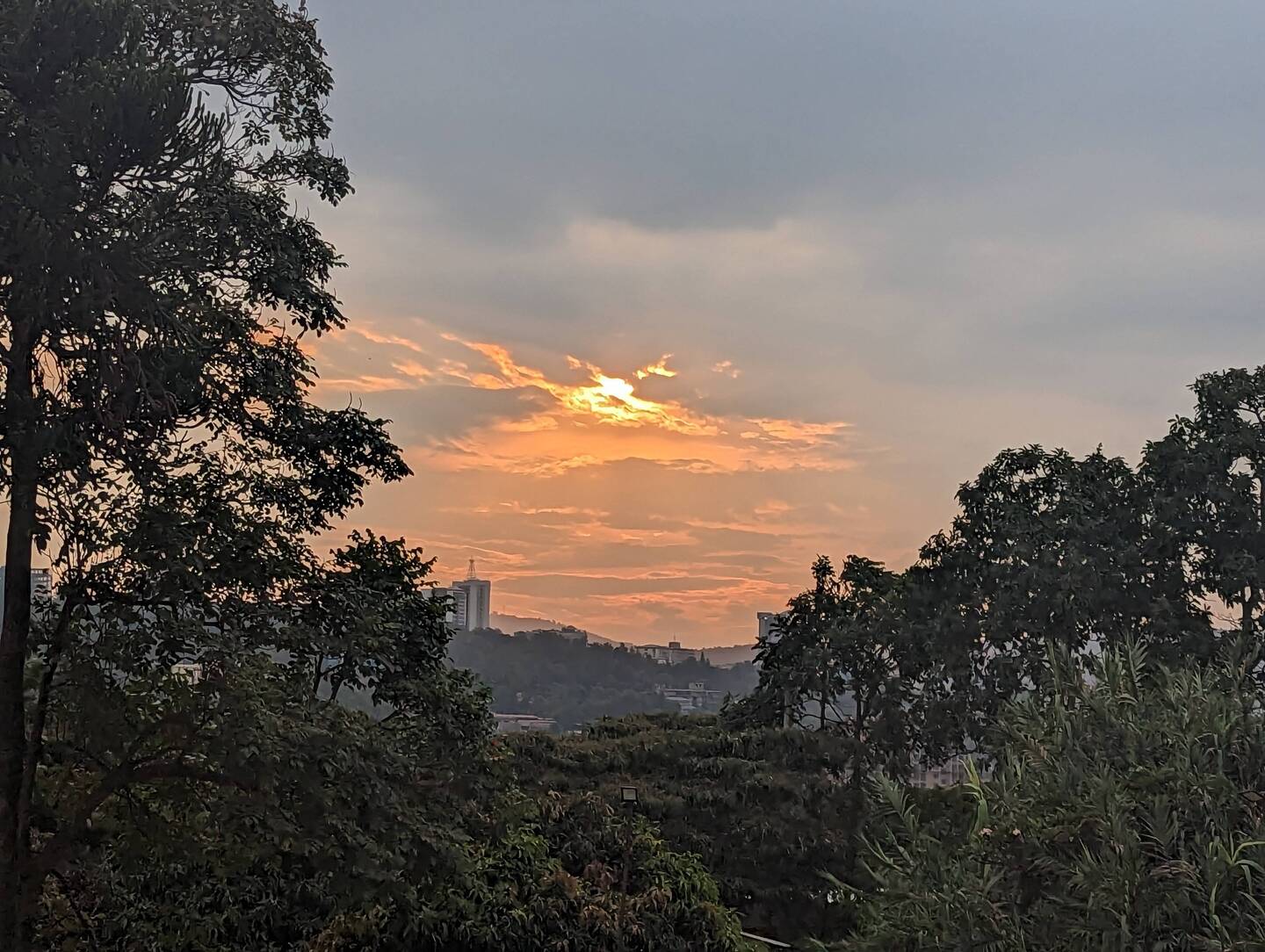

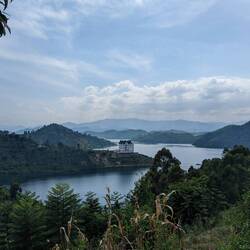


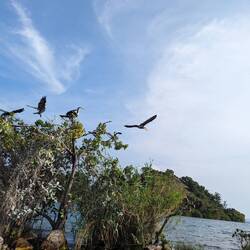
















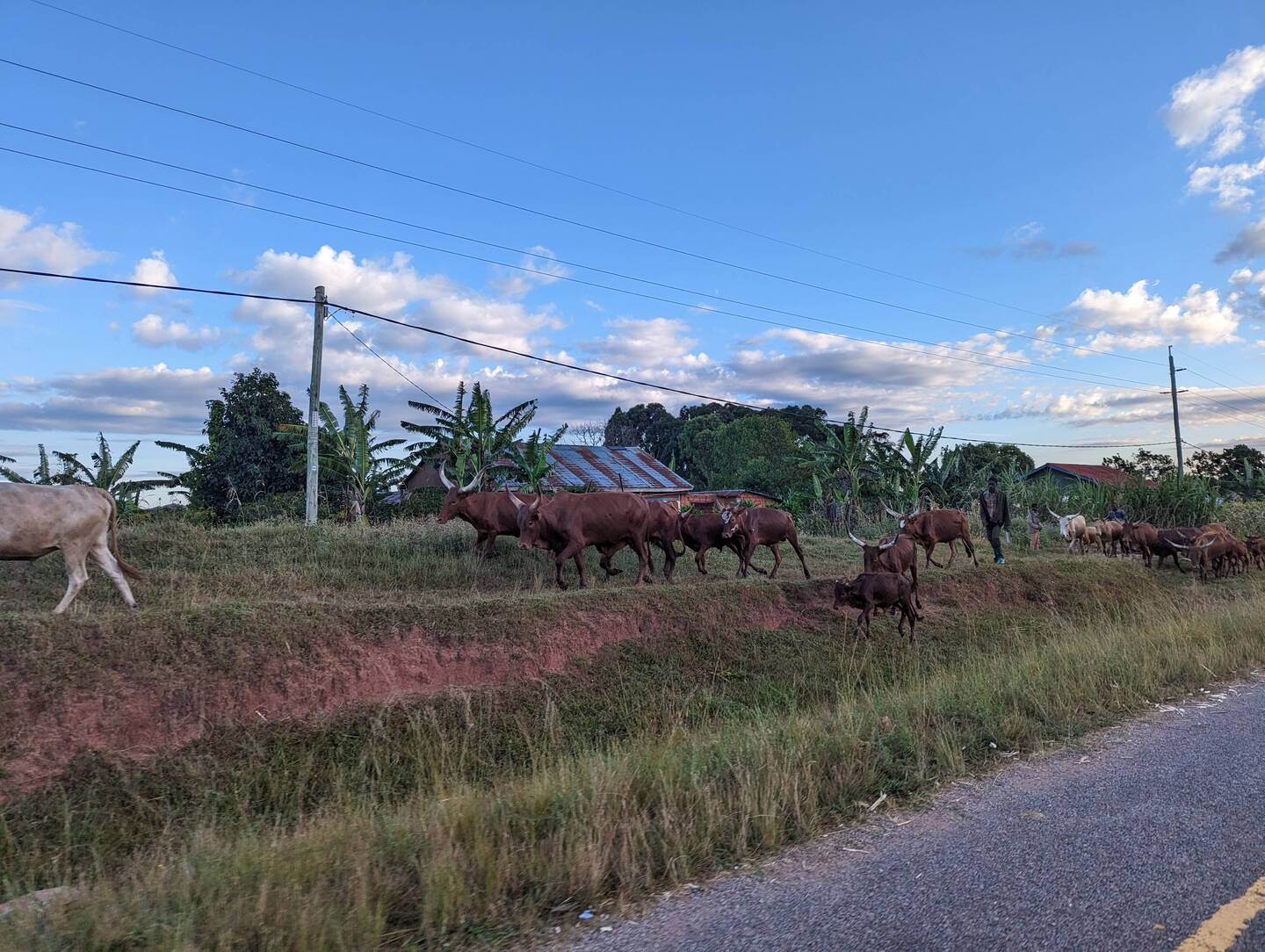

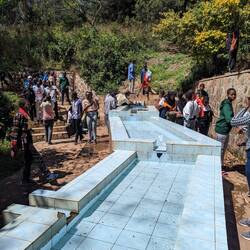
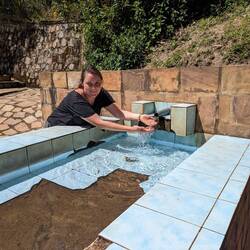
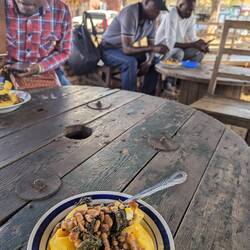
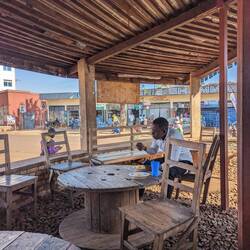











































































































































































































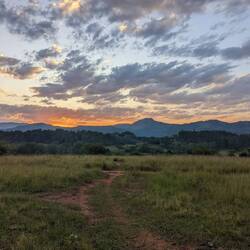
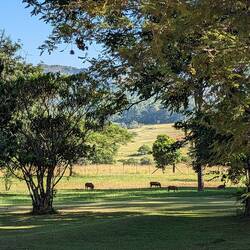
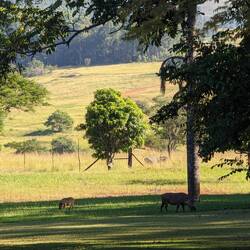


















































































































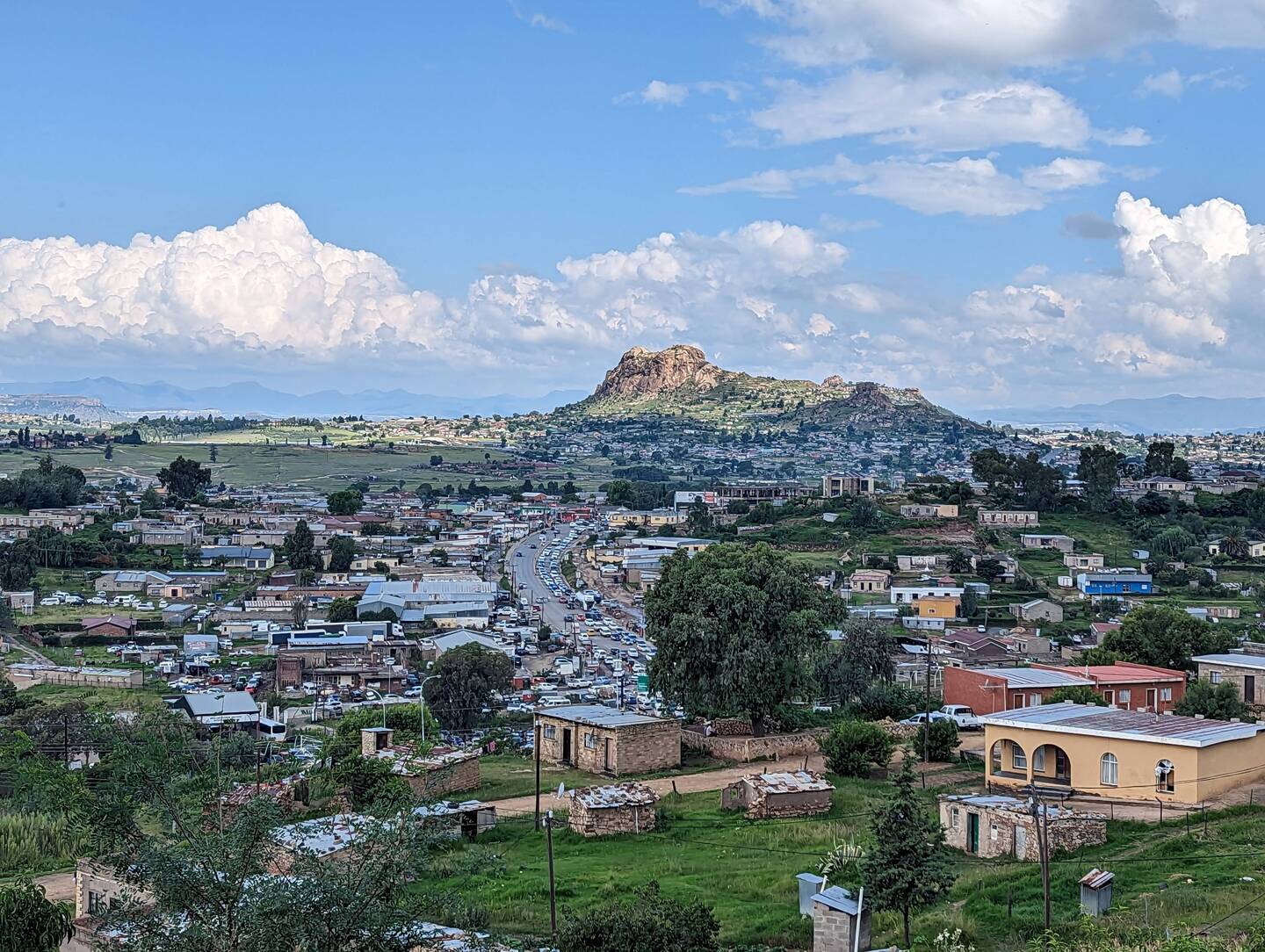
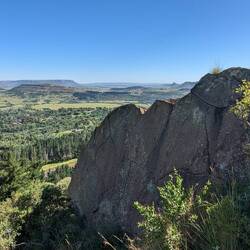
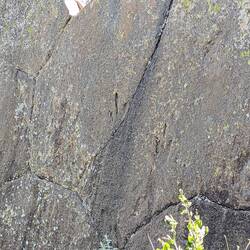
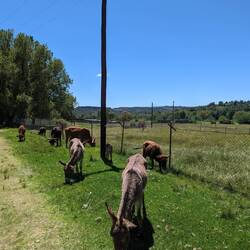
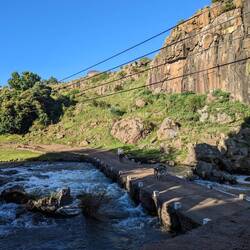
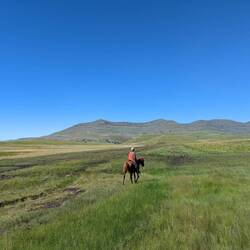





























































































































































































































































TravelerAmazing! The gorilla trek is on my bucket list! And the little baby gorilla 🥰 What an incredible journey!
TravelerYou have to do it! It was such a great experience, and Rwanda is beautiful 💖
Traveler Dreamy 💖
Dreamy 💖